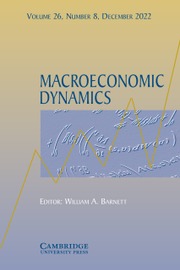No CrossRef data available.
Article contents
Endogenous vs exogenous fluctuations: unveiling the impact of heterogeneous expectations
Published online by Cambridge University Press: 08 August 2025
Abstract
This paper investigates the nature of financial market fluctuations by empirically testing three competing models of instability. We contrast a linear state-space model and a nonlinear Markov-switching model – both rooted in heterogeneous behavioral heuristics and capable of generating endogenous dynamics – with a benchmark linear random walk model that assumes exogenous shocks. Using monthly S&P 500 data from 1990 to 2019, we find strong evidence supporting endogenous sources of instability. In particular, models incorporating behavioral nonlinearities significantly outperform both the linear behavioral model and the random walk in short-, medium-, and long-term forecasting. Our findings underscore the importance of accounting for heterogeneous expectations and regime-switching behavior in explaining asset price dynamics.
Keywords
Information
- Type
- Articles
- Information
- Copyright
- © The Author(s), 2025. Published by Cambridge University Press

